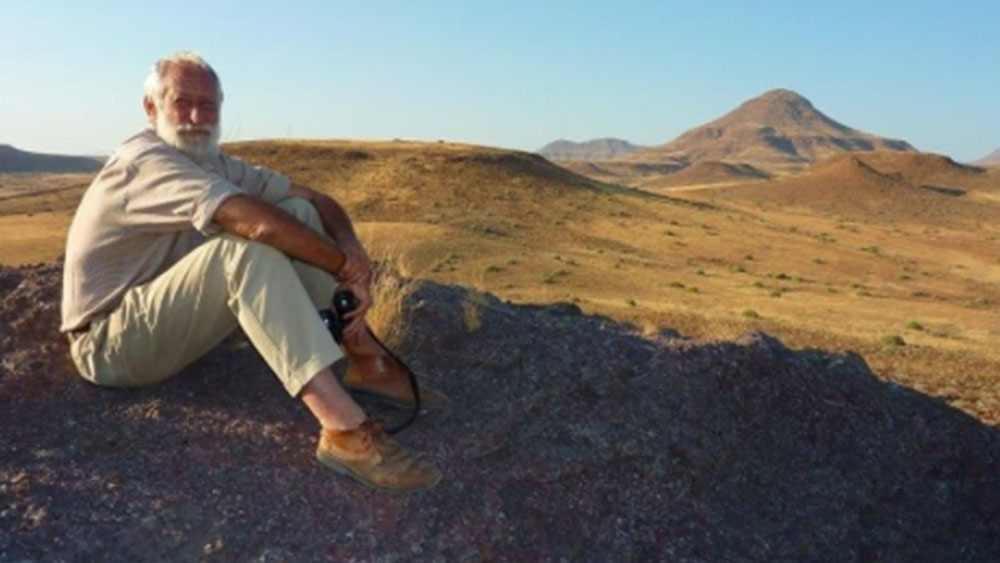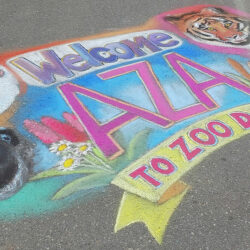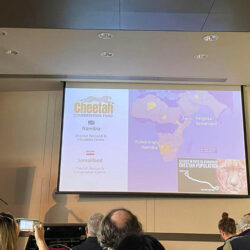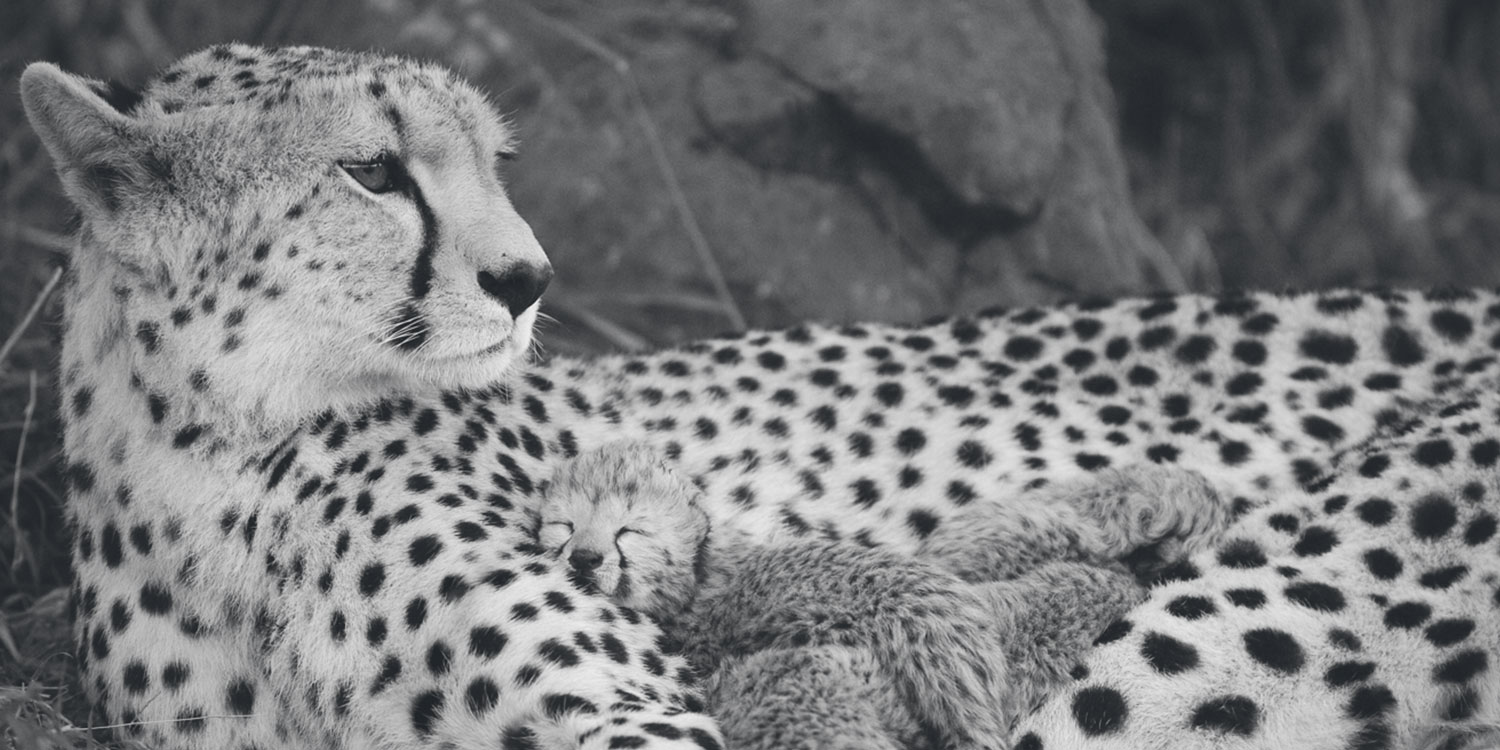A Tribute To One Of The World’s Most Dedicated Conservationists, Garth Owen-Smith
-

- by Nadja LeRoux April 24, 2020

It is with great sadness for all of us at the Cheetah Conservation Fund (CCF), and in particular CCF’s Founder, Dr. Laurie Marker, and myself, to learn about the passing of Garth Owen-Smith, a world-renowned conservationist, collaborator and friend. On behalf of those of us who knew Garth well, Laurie asked me to put together our CCF tribute to Garth.
Garth’s vision in conservation, and most of all his forward thinking, was his un-floundering belief that the key to wildlife’s conservation lay in the hands of the communities living with wildlife and not the State or other large corporates. His tireless commitment to this, and his ability to unite individuals, communities, leaders and indeed the entire Namibian nation in this principle of community ownership and responsibility, contributed to the successes Namibia sees now in how our land is utilized.
Garth was a sound believer that conservation happens on the ground, not from air conditioned offices, nor behind laptops and through endless workshops or meetings, but by embedding oneself amongst the communities living with wildlife, learning first about the ancestral and cultural connections the people have with wildlife, and acknowledging today’s challenges.
In the early 80’s whilst working with traditional leadership and headmen, he was able to revive their strong values of ownership and connections to wildlife. Garth started working with young men chosen for their skills in tracking, knowledge of the area and its wildlife to start combating the massive amount of Black Rhino and Elephant poaching occurring in the north western parts of Namibia. Their efforts resulted in a significant decline of commercial poaching incidents in the region.
Garth and his partner Dr. Margaret Jacobson established the Namibian NGO, Integrated Rural Development and Nature Conservation (IRDNC) in the late 80’s. Following IRDNC’s establishment, other NGOs followed suit and like minded people worked together to achieve the same goals and support communities living with wildlife.
The men Garth first worked with to combat the rampant poaching in the northwest of Namibia would later be recognised as the first Community Game Guards. These Rangers are the backbone of what has become an internationally recognised success story through the forming of legally recognised community conservancies. Today there are 86 gazetted communal conservancies, governed by democratically chosen committees, employ local staff, engage in joint venture tourism businesses, create community jobs and most importantly have increased wildlife numbers outside of parks all over Namibia.
Garth and Margaret’s efforts in conservation have been recognized and applauded all over the world with the couple receiving numerous awards; the 1993 Goldman Grassroots Environmental Prize for Africa; the 1994 United Nations Global Environmental 500 Award; the 1997 Netherlands Knights of the Order of the Golden Ark Award; 2003 Cheetah Conservationist of the Year Award, and the 2015 Prince William Lifetime Conservation Award from the Tusk Foundation.
Garth outlined the key steps to the survival of the world’s wildlife and communities, in his his book, An Arid Eden
- Building Relationships, “It goes without saying if you want to be listened to you have to respect the local people and their culture. You cannot expect them to be interested in your problem if you do not care about theirs.”
- Negotiation not consultation, “All too often in what has become the highly specialized field of environment conservation, policies and actions that will affect the lives of local people are drawn up by qualified professionals in comfortable city offices. At best, a few prominent and well-spoken members of the community will be called to a workshop to get their input, before the final product is taken to meetings in the affected area to get approval from the people living there. Because the visiting delegation is much better educated than the communities who will often not oppose it, and the policy is adopted, or the actions implemented, in the belief that a full consultation process has been followed. But has the local community really bought into the plan, and will they give their active support to it? Or will they just passively watch to see what happens, and carry on as usual?”
- Partnerships, “While most African countries have depended on an armed militaristic approach to commercial poaching, in Kunene a three-pronged strategy is used: management and law enforcement by the government, regular monitoring by Save The Rhino Trust, and the vigilance of the people living in and around the rhino range. Since the mid-1980’s this partnership has proven to be very successful, enabling Namibia’s Northwest to have the only thriving black rhino population on the continent”
- Benefits, “Just focusing on economic incentives, without granting local communities at least conditional ownership over valuable natural resources as well as rights to participate in management and decision making, will only have limited success”
Tirelessly dedicated to the communities he lived and worked amongst, Garth had time for everyone, would heed any call, and was available at any time. In his gentle, quiet way but with a stubbornness like no other, Garth did indeed lead the way in community-based conservation, his wisdom, teachings and example has had an effect on just about every person in the conservation fraternity within Namibia.
Garth was passionate about Namibia’s youth; if a young person had an ear, he would share everything he knew with them, usually around a campfire at night, or on a hike up a mountain. In Garth’s final paragraph of his book, he leaves a message, “My last words are to the younger readers, who can easily be overwhelmed by the magnitude and complexity of the problems the world is facing today. If you believe in a cause and are prepared to stand up for it with passion and perseverance, you can make a difference. Conserving our natural environment will not make you materially rich, but there is no greater satisfaction than having made our planet a better place to live on, even if it’s just in a very small way.”
My personal relationship goes back with Garth from 1981, when my mother first met him. At that time Garth was founding Save the Rhino Trust, which later would be taken over by Blyth and Rudi Loutit. As Garth was field based and needed to come into town from time to time, my parents provided him with a place to stay. Endless conversations were had around the dinner table and my parents, both from a teaching background, bought into his vision with a passion. Laurie met him and Margie the next year on one of her early trips to Namibia and Garth helped her learn about how to bring the communities into conservation.
In 1983, Garth got some donor funding to start operations with the first community Game Guards through a collection of people that were mutual associates of Garth and my parents. In 1984 my father and a colleague Barry Clements started the Rossing Conservation Trails, and used Garth as a guide. At Easter in 1984, my parents visited Garth’s field base, Wereldsend (Worlds End), my mother 8 months pregnant at the time, and a month later I came into the world. Over the following years was the formation of Garth and Margie’s NGO, IRDNC.
My most vivid memory was a trip our family did with Margie and Garth in 1992 to the Kunene Region with the families of some of Garth and Margie’s greatest supporters, Chris Weaver, Director of WWF Namibia and environmental consultant, Brian Jones. At the time I was 8 years old and Garth took us to the “Valley of the Tuskers”, on the western side of the Skeleton coast. There were seven of us kids on that trip, all varying ages, and Garth had us take an oath to promise that one day we would take over from Garth and Margie when we were older and ‘solemnly swear to look after the rhino and elephants.’ All seven of us have since then always had a passion for conservation, and have contributed in different ways as we’ve grown in our careers.
From 1993 – 1997 to my early teens we spent many holidays at Wereldsend where we played cricket with Garth and one-year Garth played father Christmas (Santa) to us kids handing out the gifts when we cooked the turkey in a solar oven in the bush. We would listen to ghost stories, amongst Garths many other stories about community-based conservation with stars in our eyes.
In 1999 I first met Dr. Laurie Marker who was working with my father in those years, and at 15 Laurie invited me to come to CCF during my school holidays and help out. CCF was very small in those days, and just a collection of staff dedicated and hardworking, which is still the ethos of CCF staff to this day. By that time, wildlife conservation was firmly rooted within me, and everything I wanted to do. Until 2001 I spent every chance I could get at CCF and do anything assigned to me, from exercising horses, prepping meat for cheetahs, cleaning cheetah and livestock guarding dog enclosures, guiding visitors, feeding animals, filing and on occasion tracking Cheetah on CCF lands with what now would be considered very old tracking equipment, as well as walks in the field with Laurie and ChewbaaKa where I absorbed all the lessons Laurie shared with me. It was in 2003 that CCF recognised Garth and Margie for their on-going efforts in conservation and presented them with the Conservationist of the Year Award at the CCF Annual Gala in Windhoek.
After starting my career in community conservation joint venture tourism, I joined the organisation Garth and Margie had founded, IRDNC which was operating in the Zambezi Region.
Several years later, I find myself full circle back at CCF, continuing in community base conservation. Garth has always been an inspiration for me over the years, always someone to talk to who would very easily both praise and criticise me as I progressed in my career over the years. Margie and Laurie have had a huge impact and been my inspirations as women in conservation, and their various lessons and experiences give me strength to push forward in a fraternity that is not always easy to work within, emotionally and physically tiring as combating the conservation of our wildlife and the investment in the people who coexist with wildlife is a calling, not a career choice necessarily, and to be influenced by people like them is not “lucky”, it’s a privilege.
My final words about Garth are, that with his passing, many will call him iconic, many will call him “the father of community-based natural resource management” (CBNRM) many will call him a pioneer and a hero, but Garth would remind us to look at the many steps it took for his vision to be materialized and that with each step he took he was accompanied by many others, some that have since passed, some that are still working in CBNRM and conservation around the world today and some that are the newer generation. In his humble way, Garth would remind us that CBNRM was never his idea, it was a collective journey between people who had passions in people and wildlife and through mutual respect, trust and negotiation, they found a common ground.
Garth is survived by his his sons Tuareg and Kyle, and his grandson Garth.
Related Reading
-
September 27, 2024
Representing the Cheetah at the AZA Conference -
February 19, 2024
The Addis Ababa Declaration for Global Cheetah Conservation




